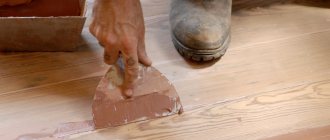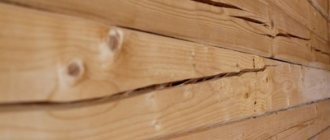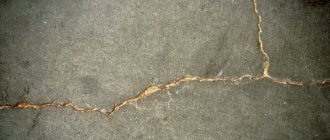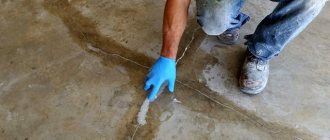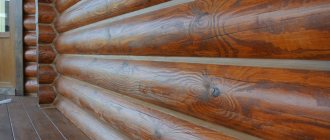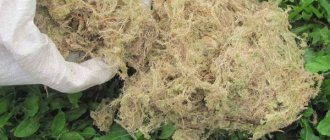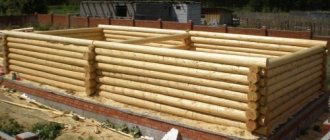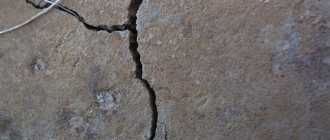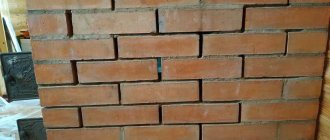How to permanently repair a crack in a timber or log.
Cracks inside wood can occur for various reasons. Sometimes they appear due to excess stress inside the wood, seasonal shrinkage, mechanical damage or other reasons. In order to eliminate them, you will need to use a wide arsenal of products - sealants, putties, adhesives and other products that are aimed at different types of defects. This article will discuss the best technologies and materials that are used to repair cracks in logs and beams - we are talking about large longitudinal cracks and small chips.
Why are cracks dangerous?
Water easily penetrates into the cracks formed in the logs and moisture accumulates. Which inevitably provokes internal rotting of the tree. And this is dangerous:
- gradual destruction of the structure;
- significant deterioration in thermal insulation qualities;
- the appearance of dangerous mold and fungi inside the building.
It was noted that the largest number of cracks appears in the first year of construction and subsidence of logs.
The explanation for cracking is simple: the outside of the wood material dries out much faster than the inside. And when solid wood remains dry on the outside and damp on the inside, this situation automatically “stretches” the outer layers of wood, while the inner ones shrink. The result is the rupture of wood fibers and the formation of cracks on their surface. Moreover, the faster the tree shrinks, the more cracks appear on it.
General description of measures for sealing seams in a wooden house
Sealing seams is part of comprehensive work on insulating wooden houses in order to eliminate the risk of “cold bridges” and destruction of materials due to the accumulation of internal moisture or debris. As a rule, they are carried out in combination with trimming and sealing areas adjacent to the foundation, roof, window and door openings. The essence of these works is to fill the joint space with elastic, highly adhesive sealants with low thermal conductivity.
The requirements for sealing materials are quite stringent; in addition to the listed properties, they must be as resistant to ultraviolet radiation and other atmospheric and biological influences as possible. At the same time, sealants must remain breathable and capable of removing accidentally accumulated condensate. For obvious reasons, only a few expensive brands of sealants meet these requirements, which is one of the few disadvantages of the technology.
Specialized sealants for wood do not have a negative impact on the natural processes of shrinkage and movement of a wooden frame. Moreover, sealing the seams with elastic and highly adhesive sealants eliminates the risk of new cracks and deformation of wooden walls.
Significant investments in materials pay off in any case. Seams protected by sealants are not susceptible to destructive moisture and biological influences (moisture does not accumulate inside, insects or fungal microorganisms do not multiply). A wide range of colors allows you to choose a sealant to match the wood and improve the appearance of the log house.
The technology is valued for its efficiency and reliability; if all requirements are met, high-quality sealants protect the seams of wooden houses for decades. In this regard, they compare favorably with natural, but short-lived caulking materials that require renewal or additional compaction every 3-5 years.
Is it possible to minimize the risk of splits?
The only condition that guarantees minimal cracking is prolonged drying of the logs under natural conditions.
Long-term drying of wood:
- Increases the strength of the log.
- Significantly extends its service life.
When drying logs naturally, it is important to ensure their uniform drying, that is, the same drying rate for both the outer and inner layers of the log house.
This can be achieved by creating certain conditions for complete drying. This is a cool and completely dry place in which the logs are allowed to dry out for at least 2 years.
From the appearance of the cracks we can deduce how long the wood has been drying:
- 1.5-2 years: crack size up to 2-2.5 mm.
- 1-1.5 years: the splits are already expanding to a width of 7-12 mm.
- Several months: the cracks become larger and occupy a distance of 12-25 mm.
To minimize the risk of faults, a compensation (unloading) cut is sometimes formed on raw logs. This measure relieves the growing stress on the wood fibers and ensures they dry out faster.
The cut is carried out according to special standards:
- it is performed along the log;
- has the appearance of a neat, even groove;
- has a thickness of 7-10 mm;
- it is made with a depth of no more than 1/4 of the diameter of the log itself.
When cutting, to protect the tree from moisture, when collecting, the timber is laid with the cut facing up so that the cut is covered by the log lying on top.
Causes of cracks
When cracks form in the walls of a log house, most owners of such households think about the reasons for their occurrence. In fact, they depend on many factors that affect the tree from its birth to the harvesting of the log.
The key root cause is the uneven shrinkage of logs from the end and sides, under the influence of which internal stresses are created in the fibers, leading to rupture. Especially massive cracking occurs during sudden temperature changes.
On the sunny side of the wood, the density decreases due to a rapid decrease in the level of moisture, and on the cold side it will remain high.
Main reasons:
- The place where the tree grows determines how much the tree has defects - curliness of the wood. Usually, any natural defects are later overgrown with new fibers and hidden by layers of the most ancient growth rings, but during the drying process of the felled tree they are revealed, appearing on its surface in the form of cracks.
- Uneven drying of logs.
The layers closest to the surface dry faster than the inner layers. A situation is created when the outside of the log is almost dry, but the core remains saturated with moisture. As a result, stress occurs on the fibers. The surface layer is subject to a tensile force, and the internal layer is subject to a compressive force. They literally explode the wood from the inside. The process depends on the drying speed; the higher it is, the more cracks there are, and their sizes are wider and deeper. - Shrinkage processes. As a result of such influences, wooden parts twist, changing their shape and linear characteristics.
- Sudden changes in temperature and humidity levels in a finished house as a result of operation. Trying to properly “heat” a home in the first winter season will most likely result in the formation of through cracks due to the difference in temperature and humidity of the walls of the log house.
- Time of year for logging. If it was a warm period, cracking will be high; the best period for harvesting wood for felling is winter.
How and with what to effectively solve the problem
But what to do when cracks have already appeared? There are many ways to help quickly and efficiently deal with this problem.
Sealing with putty
Of course, it will not be possible to completely get rid of the cracks that have appeared. But it is possible to completely seal them and prevent the risk of growth.
You can use one of the following sealing options:
Sawdust and PVA mass
This is a homemade sealing impregnation, which is the most affordable. Its components are mixed in the proportions necessary to form a thick base, similar to putty. The mixture is used to completely fill the cracks (if after drying part of the mixture falls off, this place is re-filled with homemade putty). For convenience, use a regular spatula.
wood chips
It is used to seal very deep and large cracks. It is better to select chips of the same length as the logs. The pieces of wood are first sharpened with a wedge and hammered tightly into the splits. The top is additionally reinforced with ready-made putty or homemade PVC putty.
Gypsum with sawdust or crushed bark
This mass is also called “arbogypsum”. This method of sealing provides the log with durability and reliability. To make the mass, dry gypsum powder is mixed with bark or sawdust. The mixture is thoroughly kneaded and diluted with water (the volume of liquid is equal to 1/2 of the gypsum mass). The finished putty is dense and very elastic; it must be mixed to destroy lumps. To enhance penetration, add a little regular shampoo. The crevices are covered immediately after the mass is made (it hardens instantly).
Moss
For larger splits, use moss caulk. Moss is an environmentally friendly and completely safe raw material. It will cover the cracks perfectly. It will also additionally retain heat in cold weather, blocking the access of cold air. Dried moss is used for putty. Before use, it is soaked for 20-30 minutes in clean water, squeezed out and rolled into strong rollers, which are placed in the cracks. Using a mallet, hammer it in more tightly until the layer springs back. After 3-4 days (during this time the moss dries out), the excess material is carefully trimmed off.
All these methods from folk craftsmen will ensure quick and reliable sealing of cracks using readily available means. But don’t forget about ready-made drugs.
Choosing putty
To carry out work on the surface of logs, it is necessary to use products that, in addition to reliable sealing of seams, will protect the surface of the log from frost and rain.
Expert opinion
Levin Dmitry Konstantinovich
Water-based putty, which is thick, will adhere much better and stronger to wood than liquid compounds that contain solvents. Such (liquid) putties are best used for sealing faults that are too large and deep.
There are three types of putties for processing log houses:
. With no odor and good environmental performance. It is easy to apply and dries instantly without allowing moisture to pass through. At the same time, acrylic putties also level the surface and, after drying, do not shrink (dry without cracks). They are best used for sealing small cracks.
Acrylic- Water resistant . It is famous for its high resistance to aggressive manifestations of the external environment (rain, snow, high humidity and temperature changes). Waterproof products are prepared on an adhesive, polymer or oil base, which guarantees good application and quick drying. They are best used when subsequent coating of logs with varnish or paint is planned.
- Plaster . It provides a good microclimate, is environmentally friendly and easy to use, it is better for sealing cracks in logs inside a building. After application and drying, the seam can be further sanded and painted.
- Non-shrinkable . The most durable and high quality of all other types. It is worth working with when sealing serious, deep cracks. By the way, you can choose the color of the non-shrink putty to match the wood being processed - it is available in a variety of colors.
Additionally, it is worth studying the rating of the best manufacturing companies producing putties for sealing cracks in log logs:
| Brand | Advantages | Flaws |
| Tikkurila (Finland) | resistant to temperature changes and humidity, cold-resistant, | high cost, |
| Extra (Russia) | allowed to be used to close faults, both internal and external | Almost all types of putties are acrylic, and they are not suitable for sealing deep cracks |
| Eurotex (Russia) | Nice packaging and packing, it’s easy to work with, the mixture fits perfectly and dries quickly | shrinks after drying, poor color palette |
| Parade (Russia-Sweden joint company) | increased water resistance, easy to apply, after drying can be sanded and sanded | excessively liquid composition, which is inconvenient when sealing cracks, spreads |
| Rainbow (Russia) | dries quickly, is moisture resistant and has low shrinkage | You can work with it only at a temperature of +15⁰С |
Choosing a sealant
Sealants are another common substance that helps to properly seal log cracks. They will additionally insulate the building and are guaranteed to stop the occurrence of new chips in the logs.
When applying sealant, pay special attention to the processing of the ends (they dry out faster than other areas). The ends can also be sealed using drying oil, varnish, oil paint or wax.
The main advantage of this material is the ease of application and the speed of filling cracks. When selecting a suitable sealant, take into account the composition, its technical parameters and color palette.
The following types are used to close splits:
. Resistant to temperature fluctuations and high humidity. This product is environmentally friendly and odorless. It is better to use it for filling internal cracks.
Acrylic- Silicone . A universal substance created for work both inside and outside buildings. Resistant to temperature changes and aggressive external environments. But they are not designed for subsequent painting, although this is not a problem, since manufacturers offer silicone sealants in an expanded range of colors, including transparent ones.
- Bituminous . The most resistant sealant to moisture. It contains rubber and bitumen. Similar products are used to close splits in wood roofing and drains.
- Polyurethane . It has high strength, is resistant to moisture, is a very elastic material, and is easy to work with. But take into account its harmfulness due to the presence of certain additives in the composition. Therefore, it is better to use it for work only on the outside of the building.
When choosing, you need to understand the manufacturers offering popular types of sealant:
| Brand | Description | Add-ons |
| Neomid (Russia) | has high elasticity, resistant to moisture and temperature changes | it is possible to seal fractures with a deformation of 15-30% |
| Eurotex (RF) | a particularly resistant and elastic substance, it can be used with end-side splits | acrylic appearance, additionally provides protection against insects |
| Remmers (Germany) | resistant to aggressive environmental influences, temperature changes, well compatible with paint and varnish coatings | designed for sealing cracks inside and outside buildings, available in transparent and colored versions |
| Ceresit (Poland) | resistant to humidity, temperature changes, gives minimal shrinkage | are produced in the form of silicone/acrylic compounds |
| Check Mate (America) | belongs to elite materials, perfectly protects wood from mold and moisture, gives little shrinkage | acrylic compounds with good elasticity |
When working with sealing compound, do not fill cracks to the brim with it. It is necessary to apply the mass so that it touches only in two places, connecting the opposite parts of the split. When it dries, it will fill the crack on its own.
Modern sealing materials
In addition to the environmentally friendly materials that nature supplies us with, there are modern synthetic materials offered by domestic and foreign industry. Of course, one can argue about the environment, but reliability is guaranteed by the manufacturer.
Silicone sealant
There are many special sealants based on polyurethane. It is not susceptible to temperature changes and is resistant to ultraviolet rays. Putty based on it is quite suitable for sealing the seams of house crowns.
You cannot use polyurethane sealants sold in bottles to seal joints - they are not designed for direct exposure to sunlight!
Log putty
Putting joints with silicone One of these materials is silicone sealant. Since wood tends to absorb moisture and evaporate it, this sealing method is questionable, because evaporation under the sealant layer will not occur, which will sooner or later lead to the formation of rot.
Modern thermal insulation materials are resilient and elastic, so they are used quite widely when solving the question: how to seal seams in a bathhouse.
Their peculiarity is that it is easy to work with such sealants, they dry quickly, and it is possible to apply several layers if necessary. And this is convenient and profitable.
In addition, modern sealing materials have high adhesiveness, which significantly increases thermal insulation properties, and are not afraid of drops and changes in air temperature and humid environment
But, perhaps, the most important thing is that they do not interfere with the ventilation of the room and are safe for health. Sealants not only seal the seams of the bathhouse, but also any splits and cracks that form in the wood over time
Among the newest materials for preserving heat in a bathhouse, special sealing tapes should be noted. They need to be distributed in the space between the beams. They hardly caking, which means that there is no need to use other sealing materials, which creates additional savings. In addition, such a sealant can change its shape when the logs begin to move during the natural shrinkage of the bath.
Useful tips
Regardless of what exactly is used to seal cracks - homemade putties, putties or sealants, there are uniform rules.
Knowing the rules, the work on sealing cracks will become better and more durable:
- Carry out such events in the warm season, at above-zero temperatures.
- Before applying any composition, thoroughly clean the surface to be treated from debris, dirt and dust.
- Make sure that the tree is not wet after rain. Choose dry weather for such events.
- If the split is serious and large, pre-glue its edges with masking tape. This will prevent the composition from reaching other places.
- If sealant is accidentally spilled on the surface, wait until it dries and carefully clean the area with sandpaper.
- After finishing the work, the former crack is moistened with water and leveled (you can use a brush). This will give the log a neat and smooth look.
What means would you use to repair cracks in logs?
People's Professional
When planning to build a cottage, house or bathhouse from a log house, select only high-quality logs. It is better if they come with pre-treatment with antiseptic compounds and after prolonged drying. This will protect the wood not only from splitting, but also from the appearance of mold and fungal colonies.
Sealing with sealants
Acrylic or silicone-based joint sealants can eliminate cracks up to 5 mm wide. In addition, they are used to seal seams between crowns. The consumption of such materials is 1 kg per 6–8 linear meters, if the seam thickness does not exceed 5 mm.
It is necessary to assess the condition of the logs and purchase the required amount of material. Sealants are very convenient for carrying out repair operations due to their release form: a special syringe gun allows you to cleanly apply the composition to the surface of the wood and obtain the desired result.
Siliconized sealant is a more durable option, it is resistant to deformation and holds better. For very deep fractures, you can additionally purchase a silicone cord: it is placed in the gap and covered with a compound on top. The work is carried out as follows:
- First you need to assess the number and size of damage. The surface should be thoroughly cleaned of dust and should be free of frost and snow. It is not recommended to apply the sealant at sub-zero temperatures.
You should stick masking tape on the sides of the log - it will allow you to leave the rest of the surface clean, and you won’t have to put it in order for a long time. First, a cord is placed into deep cracks, after which they are filled with sealant using a syringe gun or spatula. If it gets on the very surface of the wood, it should be washed off immediately with a damp cloth. If it hardens, the log will have to be carefully sanded with fine sandpaper. Very soon the sealant will harden and reliably close the defect. The treatment must be repeated periodically, since during the process of shrinking and drying of the wood, small cracks will appear again.
It is better not to carry out major renovations of an old house yourself, but to invite professionals. They will not only complete the job faster, but will also treat all cracks with special compounds and tools, which will allow you to forget about repeated repairs for a long time. This service is not that expensive, besides, it saves a lot of time, and the result will be more reliable.
Cracks in rounded logs are inevitable, so it is very important to carry out timely, high-quality repairs. Annual care for a wooden house is necessary, otherwise the wood can quickly collapse
A large selection of modern products makes it possible to eliminate all damage and restore the strength of the material. After repair it can last for many years
However, it is important not only to carry out repairs on time, but also not to skimp on the quality of lumber, and also to strictly adhere to all construction technologies and rules.
https://youtube.com/watch?v=hH0Nc46T4dM
Semyon Tumanov
Author of publications on 1Drevo.ru with the topics: Windows in a log house | Outbuildings made from cylinders | Cracks in logs | Siding under timber | Bathhouse with attic | Cost of cylindering | Calibrated log | Gas boiler | House foundation made of timber | Autonomous septic tank | Cottage villages | Insulation of a log house | Wooden cottage, etc.
Sealing log ends
Compared to the other surface of logs, they dry out most intensively at the ends. And this process is accompanied by the formation of multiple cracks. To reduce cracking, it is necessary to block the release of moisture from the inner layers of wood by covering the ends with sealant. The insulating layer of sealant will redirect moisture inside the beam, from where it will evaporate gradually and evenly.
In the past, the ends of logs and beams were sealed with lime. Today, wax solutions, drying oils, oil varnishes and paints are used for this task.
A mixture of glue and wood shavings
In those places where the putty composition will sooner or later begin to crack due to various factors such as seasonal fluctuations, a self-made glue filler will be able to withstand the test of time.
It is recommended for use for sealing cracks along carpentry joints, repairing cracks in wood doors and other places where the seam is subject to stress. We suggest you familiarize yourself with How to cover up cracks in a stove with fireclay clay. How to cover the stove to prevent it from cracking - folk and modern methods
Ideally, the adhesive should be mixed with fine wood dust that is generated during sanding. When drying, this composition will shrink significantly. Therefore, when filling cracks, it should be applied in large quantities, so that it protrudes above the surface. After everything is dry, you can carefully remove the excess using a sharp chisel, and the area that has been repaired should be sanded with fine-grained sandpaper.
Characteristics of specific brands of putty for wooden surfaces, rating of the best of them
Putty mixtures are produced by Russian and foreign companies.
The list of popular brands includes the following:
- "Tikkurila";
- "Eurotex";
- "Master's Choice";
- "Bolars";
- "Lakkakitti";
- Benlinka;
- "Rainbow" 0023;
- EP-0010, etc.
Manufacturers produce materials that differ in texture, purpose, cost, and composition.
"Tikkurila"
Tikkurila brand putty is diluted with water before use. The coating is applied in a layer of up to 2 mm to prevent cracks. The manufacturer produces putties with imitation of natural wood (pine, oak, birch, beech, mahogany).
The line includes a universal white blend. After applying the putty layer, additional painting of the surfaces will not be required. However, when restoring defects and irregularities, varnish, stain or dyes can be applied over the putty.
Consumption is carried out at the rate of 1 liter per area of 1 m2 when applied in a layer of 1 mm. The mass is applied with a trowel, cracks and cracks are sealed with a spatula. The treated bases dry in 4-6 hours. Then the surfaces are sanded.
The material is used to correct unevenness on wooden furniture, doors, floor coverings, etc. It is recommended to fill deep uneven areas in 2-3 layers. Products are stored in a cool room, the air should be dry.
Belinka
The Belinka brand produces putties for finishing wood, correcting joints, defects, and irregularities. The putty contains acrylic dispersion and fillers. The material is plastic, easy to apply, effectively corrects unevenness, cracks, chips, and dries quickly. The putties have good adhesion and are therefore suitable for processing different types of wood. The mixture does not have a strong odor, is environmentally friendly and is suitable for finishing interior spaces (bedrooms, children's rooms), wooden furniture, etc. The material can also be used for facade finishing.
Mixtures allow you to imitate the shade of natural wood (pine, light and dark oak, beech, mahogany). After drying, the white putty can be tinted to a suitable tone using paints and varnishes. The coating is applied in 1-2 layers. Consumption is about 1 kg per 1 m. The multilayer coating dries in 4-5 hours. Work is carried out at a temperature not lower than +10 °C. The shelf life of the material is 24 months. During storage, freezing is not allowed; the optimal temperature to maintain the technical characteristics of the composition is within +5…+30 °C.
Eurotex
Eurotex putty is used to correct unevenness and prepare wooden bases for painting and varnishing. After drying, water-dispersed dyes and varnishes can be applied to the treated surfaces. The composition is suitable for finishing facades. The advantage of the putty is its easy application, quick hardening, and easy sanding after drying. The coating is matte, uniform in composition.
"Rainbow" 0023
Putty brand "Rainbow" 0023 is characterized by high elasticity, low shrinkage, and after hardening it is resistant to deformation. The material is used to correct seams on wooden surfaces. The composition has good adhesion and durability. A 1 mm thick coating dries in 4 hours at a temperature of about +20 ºС. The material is made from environmentally friendly components, is resistant to high humidity and ultraviolet rays, and can be used for interior and facade decoration.
EP 0010
Epoxy putty EP-0010 is used for correcting deep cracks, chips, and priming substrates for painting. The composition is resistant to high humidity, has good adhesion to wooden bases, and therefore can be used for facade finishing. The putty is used for finishing interior spaces with high air humidity (kitchens, bathrooms). The mass is applied with a spatula or by spraying. A hardener is added to the composition to increase the durability of the finish.
"Master's Choice"
Putty of the “Master's Choice” brand has good adhesion, therefore it is used for processing different types of wood. The material is elastic, easy to apply, and exhibits slight shrinkage after drying. The coatings are easy to sand. The composition is universal in use and is suitable for finishing facades, interior spaces, and preparing substrates before painting.
The composition is offered ready-made in large volume packaging. The product can be used to level bases (ceilings, walls) before decorative treatment. The putty is environmentally friendly, safe to use, and comes in a wide range of shades.
"Laccakatty"
Lakkakitti putty is distinguished by its plasticity and high strength after hardening. The composition is applied to the walls with a spatula. The coating is frost-resistant, therefore it is used for facade finishing. Non-shrink characteristics reduce the possibility of cracking on surfaces. The composition is moisture-resistant and resistant to climatic precipitation. No toxic components are used in the production of the product, ensuring safe operation.
Epoxy resin
Using epoxy resin is the most reliable method for repairing cracks. Two-component products consisting of resin and hardener are easily modified into adhesive filler. With their help, you can obtain a composition of the desired viscosity and color, which will fill cracks, chips, potholes well and provide strong bonding.
After curing, epoxy resin gains strength that exceeds the strength of wood, and due to its fluidity and good adhesion, it penetrates into all cavities and thus restores the integral structure of the wooden product and prevents the further spread of cracks. This method is often used when working with solid wood, where, due to high internal stresses, the problem of cracks is especially acute.
After complete hardening, the epoxy resin turns into an inert and safe plastic of high strength. Epoxy can be used to repair defects in food contact items, such as repairing kitchen countertops or repairing cracks in a cutting board or dining table.
Epoxy resin allows you to not only fill a crack and hide a cosmetic defect, but also completely stabilize the wood. Often this is the only opportunity to restore life to a workpiece that seems hopelessly damaged by through cracks, as in the example shown below.
Putty
This technique is used in cases where there is a small crack or chip on the tree.
It is important to note that sealing cracks using putty gives a cosmetic rather than a practical effect. Moreover, even such sealing of cracks will allow you to perform any operations on the tree again, without fear of damaging it even more (for example, you can safely saw it)
Also, it is strongly recommended to putty before painting the material. To eliminate defects, you must first prepare a mixture purchased at the store. The resulting substance is applied to the damaged surface using a staple so as to fill all the cavities. You will definitely need to wait for the mixture to dry (this will take 15-20 minutes), after which you can begin secondary processing.
We suggest you read: Paper beacons are a myth, they don’t exist
What happens if you don't seal the cracks in the logs?
The web of cracks that appear on the logs of the log house, as well as fairly deep crevices, have an extremely negative effect on the appearance of the structure, which actually spoils the mood of its owners. However, cracking of wood is not only a spoiled aesthetic component, but also a wide variety of repair problems. That is why, when cracks appear on the logs of a log house, you should not remain idle, but rather use proven methods to seal them. Note that cracks quite noticeably reduce the strength of the entire building structure, several times
We draw your attention to the fact that all the calculations that were made during construction and arrangement were based on the homogeneity, as well as the integrity of the material, that is, wood. A cracked log beam can ultimately simply cause the destruction of the entire supporting structure
DIY wood putty
It is possible to make the putty solution yourself, saving money. But quality ingredients are chosen. The chalk is crushed to a powdery state and mixed with PVA glue; it is necessary to create a homogeneous mass in the form of sour cream. You can add sawdust to the mixture. Drying lasts 24 hours.
Or the chalk is dissolved in varnish with an acrylic base, which is water-soluble. Achieve a consistency that is not too liquid; it should resemble toothpaste. Drying the layer takes 12 hours.
Cooking should be done in small portions, any smudges that form should be wiped off immediately.
Cooking should be done in small portions.
Puttying wood can improve the external qualities and strengthen the material. The process is not very difficult to carry out, for this reason you can do it yourself. But they choose the mixture carefully, taking into account the operating characteristics. To save money, it is possible to prepare a putty mixture with your own hands according to the recipes described earlier; you don’t need a large number of ingredients.
Wood defects and ways to eliminate them
Timely processing of wood and the elimination of any deviations from the norm can provide the material not only with a perfect appearance, but also extend its service life significantly. Each group of damage requires its own preventive and restoration measures, depending on the nature of its origin. Thus, correcting wood defects consists of the following steps:
- to eliminate parasitic damage, the wood must be impregnated with antiseptics, and then the damaged layer must be removed;
- knots are removed mechanically, and wooden patches are placed in their place;
- wormholes and cracks are eliminated using putty with adhesive impurities, and special resins are used for through cracks;
- roughness and irregularities are removed by grinding the surface;
- To eliminate deeper damage, a special putty is most often used, or the required layer is removed and then sanded.
Each of the above procedures has its own importance. Restoring defective wood is not only for commercial purposes, but also expresses concern for the environment
